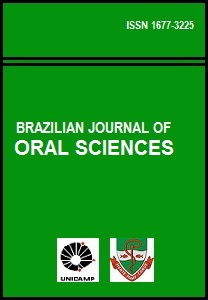Abstract
The abutment/implant interface has been reported as a significant factor on tensile transfer, adverse biological responses or prosthetic restoration complications. The abutment/implant junction success is directly related to pre-load attained during torque application. The purpose of this work was to assess the vertical fit/misfit degree on abutment/implant interface, when castable “UCLA” type abutments are used on fixed prosthesis process on implants, after different torque levels applications. Four three-unit fixed prosthesis were manufactured by the same laboratory. Torque was applied on the same framework using initially a 10 Ncm (T1) and later, a 20 Ncm torque level (T2) with a screwdriver hand Torquimeter. Trough scanning electronic microscope (SEM), it was obtained two photographs corresponding to mesial and distal regions of each prosthesis unit, summing 24 assessed regions to each applied torque value. After submitting the results to statistical analyses Paired T-Test (p<0.05), a significant difference was seen between the average vertical fit/misfit degree: T1 = 23.53mm ± 20.20; T2 = 9.01m ± 11.69 (p=0.000). The misfit degree decrease when applied manufacturers recommended torques, could decrease mechanical (loosening or fracture of the screw) complications.References
Jemt T, Rubenstein JE, Carlsson L, Lang BR. Measuring fit at the implant prosthodontic interface. J Prosthet Dent. 1996; 75: 314-25.
Michalakis KX, Hirayama H, Garefis PD. Cement-retained versus screw-retained implant restorations: a critical review. Int J Oral Maxillofac Implants. 2003; 18: 719-28.
Jansen VK, Conrads G, Richter E. Microbial leakage and marginal fit of the implant-abutment interface. Int J Oral Maxillofac Implants. 1997; 12: 527-40.
Quirynen M, De Soete M, Van Steenberghe D. Infectious risks for oral implants: a review of the literature. Clin Oral Implants Res. 2002; 13: 1-19.
Burguete RL, Johns RB, King T, Patterson EA. Tightening characteristics for screwed joints in osseointegrated dental implants. J Prosthet Dent. 1994; 71: 592-9.
Listgarten MA, Lang NP, Schroeder HE, Schroeder A. Periodontal tissues and their counterparts around endosseous implants. Clin Oral Implants Res. 1991; 2: 1-19.
Aparicio C. A new method for achieving passive fit of an interim restoration supported by Brånemark implants: a technical note. Int J Oral Maxillofac Implants. 1995; 10: 614-8.
Watanabe F, Uno I, Hata Y, Neuendorff G, Kirsch A. Analysis of stress distribution in a screw-retained implant prosthesis. Int J Oral maxillofac Implants. 2000; 15: 209-18.
Taylor TD, Agar JR. Twenty years of progress in implant prosthodontics. J Prosthet Dent. 2002; 88: 89-95.
Brånemark PI, Zarb GA, Albrektsson T. Introduction in Osseointegration. In: Brånemark PI, Zarb GA, Albrektsson T. Tissue-integrated prostheses. Osseointegration in clinical dentistry. Chicago: Quintessence Books; 1985. Cap.1 11. Gratton DG, Aquilino AS, Stanford CM. Micromotion and dynamic fatigue properties of the dental implant-abutment interface. J Prosthet Dent. 2001; 85: 47-52.
Carotenuto G, Palumbo M, Zarone F, Nicolais L. Characterization of the interface between prefabricated gold copings and cast dental alloy in implant restorations. Clin Oral Implants Res. 1999; 10: 131-8.
Tzenakis GK, Nagy WW, Fournelle RA, Dhuru VB. The effect of repeated torque and salivary contamination on the preload of slotted gold implant prosthetic screws. J Prosthet Dent. 2002; 88: 183-91.
Haack JE, Sakaguchi RL, Sun T, Coffey JP. Elongation and preload stress in dental implant abutment screws. Int J Oral Maxillofac Implants. 1995; 10: 529-35.
Cibirka RM, Nelson SK, Lang BR, Rueggeberg FA. Examination of the implant-abutment interface after fatigue testing. J Prosthet Dent. 2001; 85: 268-75.
Jörnéus L, Jemt T, Carlsson L. Loads and designs of screw joints for single crowns supported by osseointegrated implants. Int J Oral Maxillofac Implants. 1992; 7: 353-9.
Gross M, Abramovich I, Weiss EI. Microleakage at the abutmentimplant interface of osseointegrated implants: a comparative study. Int J Oral Maxillofac Implants. 1999; 14: 94-100.
Kan JY, Rungcharassaeng K, Bohsali K, Goodacre CJ, Lang BR. Clinical methods for evaluating implant framework fit. J Prosthet Dent. 1999; 81: 7-13.
Patterson EA, Johns RB. Theoretical analysis of the fatigue life of fixture screws in osseointegrated dental implants. Int J Oral Maxillofac Implants. 1992; 7: 26-34.
The Brazilian Journal of Oral Sciences uses the Creative Commons license (CC), thus preserving the integrity of the articles in an open access environment.

